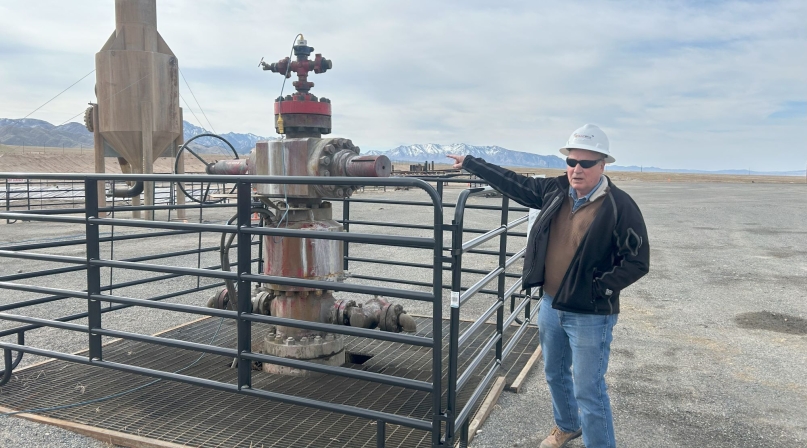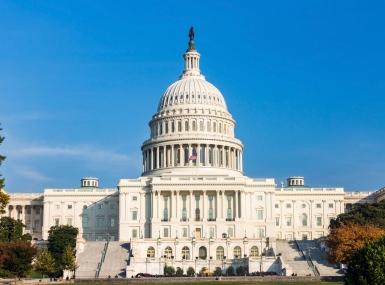County’s groundwork helps set the stage for energy breakthrough

Key Takeaways
Aside from some water towers and a flock of turbines making the best of a windy situation, there aren’t many tall structures in Beaver County, Utah. Among those turbines, a few drilling rigs are opening up a whole new world, underground.
But while high-level agreements between the U.S. Department of Energy and the University of Utah made cutting-edge geothermal energy operations happen in this 7,000 person community, the work Beaver County has done to prepare the region made it possible. In 2026, a power plant here could lead the way for 24-hour clean energy generation throughout the country thanks to new technology.
“It’s a pocket of land that most people would drive by and not think anything of it,” said NACo President James Gore, who visited the county last month. “You wouldn’t think that what they do here could produce enough power for an entire state.”
FORGEing ahead
“I think this is the right time,” for geothermal energy, said John McLennan, a chemical engineering professor at the University of Utah’s Energy & Geoscience Institute. “This is a renewable energy that makes sense.”
The Department of Energy is funding Frontier Observatory for Research in Geothermal Energy — Utah FORGE. Utah FORGE is applying multi-stage hydraulic fracturing, common to natural gas extraction, to its drilling, a new facet in geothermal energy. The result — enhanced geothermal systems (EGS) — creates more surface area for water to encounter the hot rock in the earth’s crust, creating steam that spins the turbines in a power plant to generate electricity.
The Department of Energy estimates that enhanced geothermal systems could generate power to 65 million homes throughout the United States.
Geothermal energy was once limited to locations closer to fault lines, but enhanced geothermal systems could open the map entirely, though McLennan noted that it would likely exclude urban areas.
“I don’t think you’ll see it happening in Seattle or San Francisco. You might see it in more remote parts of those states,” he said. “After hydraulic fracturing, and when you’re circulating and operating the plant, many plants have low-level background earthquakes. A plant near an urban area is going to need a more significant monitoring system for seismicity, it’s going to need a more significant hazard analysis for seismicity. And you will have cooling towers; people might not like that.”
Next door to Utah FORGE, a private company, Fervo Energy, is following in the wake of the successful tests and is working to commercialize the technology. The power generated by their planned Cape Station plant will be sold to customers in California. Fervo’s contract with Google is the first instance of an enhanced geothermal system supplying energy to a data center.
But with a smaller footprint, McLennan sees opportunities for enhanced geothermal systems to fit in new places, particularly in a way that will meet the needs of one of the driving factors in energy demand.
“Transmission is a big deal, but then you start to look at who our future users are going be,” he said. “They’re going to be things like data centers, and what you need to do is site them close to an EGS plant. It’s an opportunity to get around a transmission bottleneck.”
He sees the West as being the proving ground for enhanced geothermal systems for at least the next decade, and once this new technique is commercially viable, it will likely see adoption throughout the country. Currently, the vast majority of U.S. geothermal plants are in California, Nevada and Utah.
“Truthfully it would be nice to just see something east of the Mississippi, but that’s going to be a matter of time, I think,” McLennan said. “Once we see this can work, it’ll just be a matter of drilling deeper.”
Preparing the groundwork
Although Fervo’s Cape Station is located on private land — rare in Southern Utah — the county’s role has been and will be critical to their successes.
“You really do have to be user friendly and willing to look at all of the different issues,” said Beaver County Commissioner Tammy Pearson. “Aside from approving conditional use permits and road maintenance agreements, our job is to do the facilitation and coordination work between the federal agencies, landowners and the management.”
That effort has involved lobbying both the Department of Energy and the state Legislature, which allocated $300,000 on top of the $300 million grant DOE provided to the University of Utah.
The county also plays a crucial role in building out the workforce that will build and run the plant.
“Although counties may seem insignificant in the role that they can play (in energy generation), their influence really comes from their affiliations and relationships with others,” said Jen Wakeland, a business development director for the state of Utah who served as Beaver County’s strategic development director during part of Utah FORGE and Fervo’s development in the county.
“Maintaining relationships gives these projects the opportunity to thrive, whether it’s with universities, chambers of commerce or the community. It’s incumbent on staff to really dig in and ask how they can think about it differently, if the vision doesn’t match the market, and how can we work together to make that happen.”
By cultivating and maintaining relationships with the state and associations of governments, a county can adopt a more regional mindset and open their network to reach those of its partners.
“That allows us to deploy certain things like incentives in case a company faces some of them financial challenges or even being able to reach out to venture capitalists,” Wakeland said. “Those relationships and how you build and maintain them become the most important thing when you’re trying to set the groundwork for good solid economic development, regardless of who the developer is.”
Cooperation with universities will be critical in developing workforce training, particularly if employers in a new field plan to hire from the community. Utah Tech University and the University of Southern Utah, along with Utah State Extension, have local options.
“In rural settings, you really rely on [others],” she said. “Anytime we’ve had a rise of industry in Beaver County, we have been able to reach out to those university partners and foster the relationship to a point where we could get programs in place to help develop the workforce. Yes, we’ll need some geothermal 101, but we’ll need electrical engineering, and for managers, bachelor’s and master’s programs. We lay out the growth we anticipate and focus on the pieces we’ll need to complement that growth.
“I would say it’s equally important, in addition to all the work that needs to be done by counties, maintaining relationships probably should be up there with all the other work.”
The influx of workers will also require Beaver County to stimulate its housing supply.
“We’ve been really thoughtful about how we can temporarily house people because we know that the folks that are out here building the power plant are going to eventually go away,” Wakeland said.
The nearby city of Milford has played host to some recreational vehicles housing workers, and those parks will become recreational RV parks when the workers depart.
“The other way to address housing is just to bring in developers and say, ‘Here’s the opportunity, here’s what it’s going to look like, here is what the market will hold,’” Wakeland said. “We’ve been pretty clear with our developers that single family homes are what is going to make the most sense. We have some duplexes, and we have some fourplexes. Townhomes might be a nice option as well, because they’re cheaper to build than standalone homes, but we were really transparent with the developers about what the market will really hold. They can’t come in and think they’re going to build $400,000 houses. They’ll never sell.”
Wakeland said Beaver County has also been straightforward when advising companies like Fervo how to integrate into the community.
“There’s a road map to success for businesses to come into a rural place like Beaver County,” she said. “You join the Chamber of Commerce, you sponsor booths at the county fair, you volunteer your time to coach Little League and you make sure you’re having community meetings and town halls, where people can come in and ask questions. When you hire key influential members of the community to take key influential roles within your business, you gain credibility. You need credible community voices to lend credibility to your project.”
Related News

U.S. House of Representatives passes SPEED Act and other permitting reform bills
On December 18, the U.S. House of Representatives passed the SPEED Act (H.R. 4776). The SPEED Act would strengthen county involvement in decision-making and make needed commonsense reforms to the federal environmental review process.

House Natural Resources Committee advances the Endangered Species Act Amendments Act of 2025
On December 17, the House Natural Resources Committee advanced the Endangered Species Act (ESA) Amendments Act of 2025 (H.R. 1897). The version passed by the committee adopted several changes from the initial bill and would address key county concerns by improving the implementation of the ESA. The legislation now awaits a floor vote before the whole U.S. House of Representatives.

Counties and Railroads: Shared Priorities for the Next Surface Transportation Bill
County leaders from across the country have a vital opportunity to ensure their infrastructure priorities are front and center.
County News
Utah county closer to energy goals

